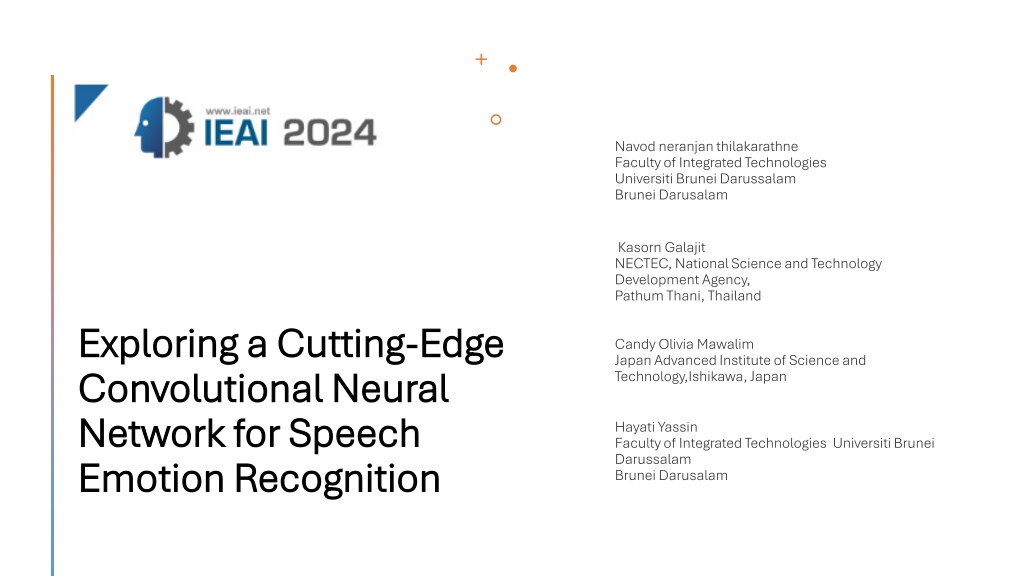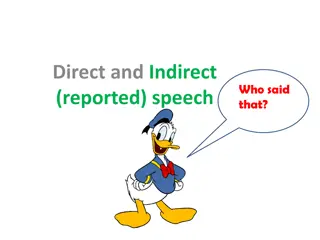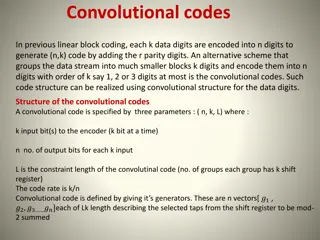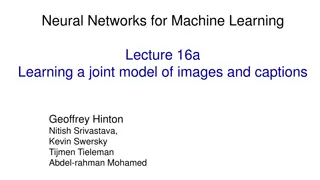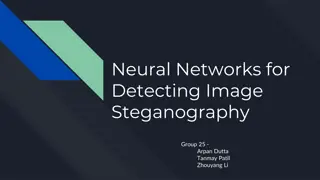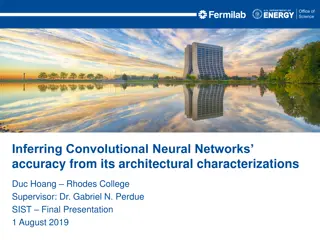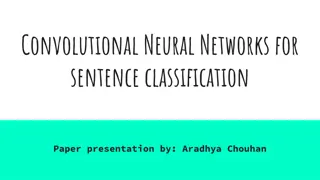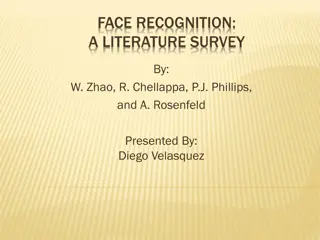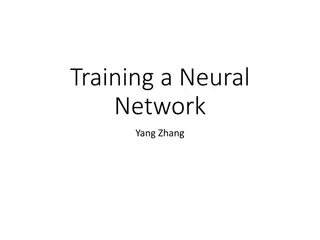Exploring a Cutting-Edge Convolutional Neural Network for Speech Emotion Recognition
Human speech is a rich source of emotional indicators, making Speech Emotion Recognition (SER) vital for intelligent systems to understand emotions. SER involves extracting emotional states from speech and categorizing them. This process includes feature extraction and classification, utilizing techniques like acoustic feature extraction, spectral analysis, and machine learning algorithms. Deep Learning (DL) techniques such as Convolutional Neural Networks (CNNs) have shown promise, outperforming traditional methods. Recent research has focused on improving emotion identification systems using CNNs with attentive mechanisms and multi-view learning objectives.
- Speech Emotion Recognition
- Convolutional Neural Network
- Deep Learning
- Acoustic Features
- Emotional Analysis
Download Presentation

Please find below an Image/Link to download the presentation.
The content on the website is provided AS IS for your information and personal use only. It may not be sold, licensed, or shared on other websites without obtaining consent from the author. Download presentation by click this link. If you encounter any issues during the download, it is possible that the publisher has removed the file from their server.
E N D
Presentation Transcript
Exploring a Cutting Exploring a Cutting- -Edge Convolutional Neural Convolutional Neural Network for Speech Network for Speech Emotion Recognition Emotion Recognition Edge
Human speech continues to be one of the most abundant and easily obtainable reservoirs of emotional indicators. Hence , Speech Emotion Recognition (SER) has emerged as a critical component in enabling intelligent systems to comprehend the meaning of human emotions. SER is the process of extracting emotional states from spoken language and categorizing them with the goal of interpreting the intricate emotional states present in spoken language so that machines can recognize a variety of emotions, such as joy, grief, rage, and others The accurate identification of emotions in speech data continues to be a multifaceted and ever-changing obstacle, demanding techniques capable of capturing the subtle dynamics, patterns, and contextual information that are inherent in audio signals As per the current status of SER research, a range of strategies have been employed, for speech analysis and classification. Background of Background of the Research the Research
SER is comprised of two phases: feature extraction and feature classification For the extraction of features, various technologies are used, such as acoustic acoustic feature feature extraction extraction (involves analyzing various speech characteristics like pitch, tone, and speed through techniques like Mel Mel- -Frequency Frequency Cepstral Cepstral Coefficients Coefficients (MFCCs) (refers to the analysis of rhythm, stress, and intonation of speech) and spectral spectral analysis analysis (involves examining the frequency spectrum of speech through techniques like Fourier Transform). Once the features are extracted, the next step involves classifying them into distinct emotions, which employs ML and DL techniques . The commonly used machine learning algorithms include Support Vector Machine, K-Nearest Neighbor, and Decision Tree, where DL techniques, including Recurrent Neural Networks (RNNs) and CNNs. In recent years, DL has drawn more interest and is seen to be a developing subject of study in SER. According to the state-of-the-art , CNN demonstrated better discriminative performance compared to other DL architectures employed and often outperformed traditional methods employed for SER. (MFCCs)), prosodic prosodic analysis analysis Background of Background of the Research the Research
Reference Reference Algorithm/technique Algorithm/technique used used Scope Scope of of the the study study (Zheng (Zheng et et al al. ., , 2015 2015) ) CNN This research presents a methodical approach to the implementation of an efficient emotion identification system that is built on deep CNNs. (Neumann (Neumann & & Vu, Vu, 2017 2017) ) CNN The research involved using an attentive CNN with a multi-view learning objective to assess system performance. This assessment was based on varying the length of the input signal, experimenting with different acoustic feature sets, and analyzing various types of emotionally charged speech. (Badshah (Badshah et et al al. ., , 2017 2017) ) CNN Presents a method for SER using spectrograms and deep CNN. (Huang (Huang et et al al. ., , 2014 2014) ) CNN The study introduces a method where a semi-CNN is used for learning features that are crucial for emotion detection in speech. State of the Art State of the Art (Lim (Lim et et al al. ., , 2016 2016) ) CNN and RNN The authors have designed a SER model based on CNN and RNN and evaluated on emotional speech data. (Issa (Issa et et al al. ., , 2020 2020) ) CNN In order to identify emotions, the authors present a novel architecture that utilizes features extracted from sound files, including spectral contrast, chromagram, mel-frequency cepstral coefficients and tonnetz representation, and chromagram, as inputs for a one-dimensional CNN. The authors propose a real-time CNN for SER to recognize three emotional states in the study. (Bertero (Bertero & & Fung, Fung, 2017 2017) ) CNN (Tzirakis (Tzirakis et et al al. ., , 2018 2018) ) CNN and LSTM The authors present a novel continuous SER model using CNN and LSTM. (Mao (Mao et et al al. ., , 2014 2014) ) CNN The authors proposed using CNN to discover affect-salient features for SER. Their experimental findings on benchmark datasets demonstrate that the method employed produces consistent and dependable scene recognition performance. (Zhang (Zhang et et al al. ., , 2018 2018) ) CNN The authors investigated how a deep CNN can be utilized to bridge the emotional gap in voice signals.
Motivated by the fact that designing a more efficient way of identifying emotions through human speech, this study presents a novel CNN architecture for SER. By harnessing the capabilities of DL, this proposed architecture achieves exceptional accuracy in distinguishing human emotions from speech data Propose a novel CNN model for speech emotion recognition integrating CNN layers with Long Short-Term Memory (LSTM) layers, combining speech data from three distinct datasets for training the underlying model. Employ data augmentation techniques to improve the generalization of the proposed CNN model and prevent overfitting. Key Contributions Key Contributions
Methodology Methodology The dataset was constructed through the concatenation of data extracted from three distinct databases: the toronto emotional speech set , the crowd-sourced emotional multimodal actors dataset , and the surrey audio-visual expressed emotion database. The prepared dataset encompasses short voice messages, which include English phrases voiced by professional actors (including both male and female voices), and the data was in the .wav file format. Data were extracted in a way to contain seven types of emotions: angry, happy, disgust, surprised, sad, and fear. Final concatenated 10722 voice records. dataset contains
Data Analysis Data Analysis Emotion surprise was the lowest recorded (from the .wav files) Wave plots pertaining to fear and angry emotions Spectrogram pertaining to fear and angry emotions
Data Augmentation Data Augmentation Used to increase the amount of training data and improve the generalization of DL models whilst preventing overfitting. Random noise was added to the voice samples. A random noise was generated with the same length as the speech signal. Afterward, generated noise was added to the original speech signal to create a noisy version. Overall, adding controlled random noise to the training data can make the model more robust to these variations. It essentially trains the model to recognize the target speech even when partially masked by noise.
Feature Extraction Feature Extraction The Librosa library in Python was used. MFCC were used Once the features were extracted, empty values were removed, and NaN values were filled with 0. Next, label encoding was done to convert emotional states into numerical form, and finally, all the data were standardized using the Python Standard Scaler method. This has been done to ensure that all features have the same scale and mean, which can help improve the performance of the DL model. Afterward, as the final step, the dataset was divided into 90% for training and 10% for testing.
Model Building Model Building Input layer consisted of an initial convolution layer that was composed of 512 filters and a kernel size of 3. Following the input layer is a convolutional block consisting of a batch normalization and max pooling layer. Five more blocks are included in the final model, which is subsequently composed of two LSTM layers, a flattened layer, a dense layer with batch normalization, and a dense layer employing a SoftMax activation function. This has been finalized after several trials with varied combinations of hyperparameters that yield the best results
Evaluation Evaluation An accuracy, precision, recall, and F1 scores were recorded The hyperparameters employed in the model training are highlighted in Table 1. Overall, we have tried varied combinations of hyperparameters, where the highlighted configurations in Table 1 yield the best results. A callback function was implemented to terminate model training once the validation set reached the minimum loss threshold, where training loss decreased and showcased a linear loss after the 20th epoch The execution of the model was terminated at the 34th epoch. After model training, it was evaluated on a separate test set, and it is evident that it reached a testing accuracy of 88.76 % on test data. Table 1. hyperparameters employed in the model training Value Value Parameter Parameter Optimizer Optimizer Adam Batch Batch size size 64 Epochs Epochs 34 (early stopping call back used) Learning Learning rate rate 0.001 Categorical cross-entropy Loss Loss function function
Experiment Results Experiment Results Performance evaluation metrics Parameters Accuracy Precision Recall F1 score Values (%) 88.76 88.43 88.56 87.43 Training and testing accuracy over the number of epochs Training and testing loss over the number of epochs Confusion Matrix
Validation / Comparison Validation / Comparison Accuracy (%) Reference Employed classifier Features employed Dataset/(s) used CNN (02 convolution and 02 pooling layers) Interactive Capture (IEMOCAP) dataset Emotional Dyadic Motion (Zheng et al., 2015) Mel spectrogram 40.00 (Badshah 2017) et al., CNN ( 03 convolutional and 03 fully connected layers) Mel spectrogram Berlin dataset 84.30 CNN + LSTM ( 04 convolutional layers with the LSTM network) 88.01 (precision only) (Lim et al., 2016) Short-time fourier transform Berlin dataset (Bertero 2017) & Fung, CNN ( one convolutional layer) Mel spectrogram TEDLIUM v2 corpus dataset 66.10 Berlin database, RML audio-visual dataset, eNTERFACE05 audio-visual dataset and the BAUM-1s audio-visual dataset AlexNet pretrained CNN (Zhang Et Al., 2018) Mel spectrogram 87.31 Crowd-sourced actors dataset, toronto emotional speech dataset, and surrey audio-visual expressed emotion dataset emotional multimodal Modified CNN Our proposed model Mel spectrogram 88.76
Conclusion Conclusion Presents a novel CNN architecture that classifies and evaluates seven distinct emotional states from speech signals, with an accuracy of 88.76 %. In an era where human-computer interactions must become more emotionally intelligent, the results of this study mark a substantial advancement in utilizing DL to respond to and comprehend human emotions in a variety of technological contexts. Enhanced through continued development and refinement, this innovative SER approach has the potential to facilitate the creation of digital systems that are more responsive and empathetic, thereby elevating the standard of human-computer interactions across various domains.
